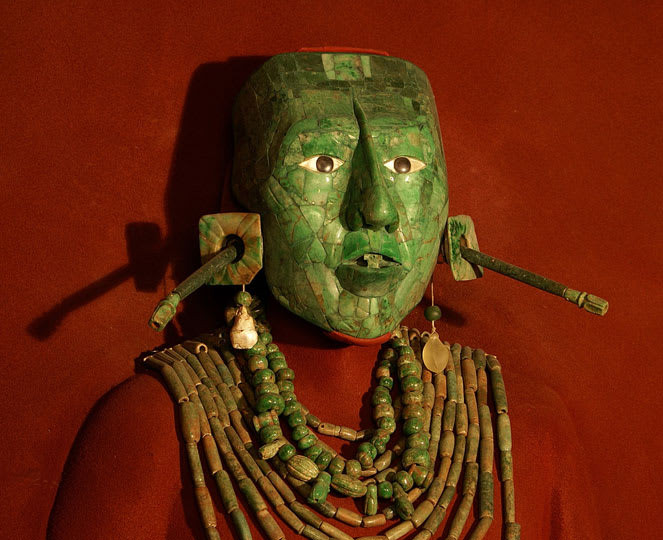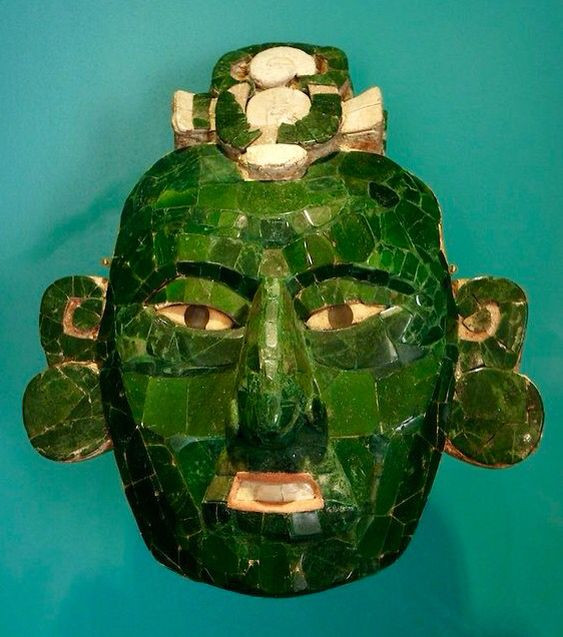Introduction: Discovering the Legacy of a Maya King
In the heart of Mexico City, the National Museum of Anthropology houses a remarkable collection that celebrates the rich cultural heritage of the ancient Maya. Among its most prized possessions are the captivating jade funerary artifacts that once adorned the legendary ruler, Pakal the Great.

Pakal the Great, also known as K’inich Janaab’ Pakal, was the esteemed king of the Maya city-state of Palenque, reigning from 615 to 683 AD. Under his visionary leadership, Palenque flourished as a center of art, architecture, and intellectual achievement, leaving an indelible mark on the history of Mesoamerica.
Upon his death, Pakal the Great was interred in a grand burial chamber beneath the iconic Temple of the Inscriptions, a testament to his enduring legacy. It was here that archaeologists uncovered a treasure trove of exquisitely crafted jade artifacts, imbued with profound symbolic meaning and offering a tantalizing glimpse into the opulent world of this legendary Mayan king.
The Grandeur of Palenque: Pakal the Great’s Reign
Palenque, the Maya city-state ruled by Pakal the Great, was a thriving hub of cultural and intellectual activity during the Classic Period of Mesoamerican civilization. Under Pakal’s leadership, the city experienced a golden age, with advancements in architecture, art, and the written word.

One of the most impressive architectural achievements of Pakal’s reign was the construction of the Temple of the Inscriptions, a towering temple-pyramid that served as the king’s final resting place. This magnificent structure, with its intricate carvings and hieroglyphic inscriptions, is a testament to the engineering prowess and artistic mastery of the Maya people.
Pakal’s reign also saw the flourishing of Palenque’s artistic traditions. The city’s sculptors, painters, and craftspeople produced works of unparalleled beauty and complexity, showcasing the depth of Mayan artistic expression. From the elaborate stone carvings adorning the city’s temples and palaces to the delicate jade and obsidian jewelry worn by the elite, Palenque’s artistic legacy continues to captivate and inspire scholars and art enthusiasts alike.
The Jade Treasures of Pakal the Great
The most remarkable aspect of Pakal the Great’s legacy is undoubtedly the stunning array of jade funerary artifacts discovered within his burial chamber. These exquisitely crafted objects, meticulously preserved over the centuries, offer a unique window into the beliefs, customs, and social hierarchies of the ancient Maya.
One of the most iconic artifacts is the magnificent jade death mask, which was placed over Pakal’s face during his interment. This breathtaking work of art, with its intricate carvings and vibrant green hue, is a testament to the Maya’s mastery of jade-working techniques. The mask’s intricate design features a serene, almost lifelike expression, suggesting a belief in the continuation of the ruler’s spirit beyond the physical realm.

Accompanying the death mask were a number of other remarkable jade objects, including a pair of earflares, a pectoral, and a number of beads and pendants. These items, which would have adorned Pakal’s body and burial attire, were not merely decorative; they were imbued with profound symbolic meaning that reflected the Maya’s worldview and religious beliefs.
For example, the earflares feature intricate carvings of the Maya maize god, a central figure in the Mayan pantheon associated with fertility, rebirth, and the cyclical nature of life. The pectoral, on the other hand, depicts a stylized representation of the Maya sky god, Itzamna, who was believed to be the patron of knowledge, writing, and the arts.
The Symbolic Significance of Jade in Maya Culture
The Maya’s reverence for jade, a semi-precious stone found in limited quantities in Mesoamerica, was deeply rooted in their cultural and religious beliefs. Jade was considered a sacred material, associated with the divine, the natural world, and the cycle of life and death.

In Mayan cosmology, jade was believed to be the physical embodiment of water, a vital and life-sustaining element. The stone’s green hue was seen as a reflection of the lush, verdant landscapes that sustained the Maya civilization. Moreover, the durability and beauty of jade made it an ideal material for the creation of objects intended to last beyond the physical realm, such as funerary masks and adornments.
The placement and arrangement of the jade artifacts within Pakal’s burial chamber also held deep symbolic significance. For instance, the death mask’s position over the king’s face was intended to facilitate his spiritual transformation and rebirth in the afterlife. Similarly, the earflares and pectoral were strategically positioned to honor and invoke the protection of the Maya deities associated with these objects.
The Enduring Legacy of Pakal the Great
The discovery of Pakal the Great’s jade funerary artifacts has not only shed light on the opulent and sophisticated culture of the ancient Maya but has also captured the imagination of scholars, archaeologists, and the general public alike. These captivating objects serve as tangible reminders of the enduring legacy of this legendary Mayan ruler.

Through the study and preservation of these artifacts, we gain a deeper understanding of the Maya’s rich cultural heritage, their beliefs, and their artistic prowess. The jade treasures of Pakal the Great continue to inspire awe and wonder, reminding us of the remarkable achievements of this ancient civilization and the enduring power of their artistic and spiritual legacy.
Conclusion: Honoring the Past, Inspiring the Future
The jade funerary artifacts of Pakal the Great stand as a testament to the enduring legacy of the ancient Maya and the lasting impact of their cultural and artistic achievements. These remarkable objects, meticulously crafted and imbued with profound symbolic meaning, offer a captivating glimpse into the opulent world of this legendary Mayan king.
As visitors to the National Museum of Anthropology in Mexico City gaze upon these treasures, they are transported back in time, marveling at the ingenuity, creativity, and spiritual beliefs of the Maya people. These artifacts serve not only as historical artifacts but as a powerful reminder of the enduring human desire to commemorate the lives of our ancestors and to preserve the cultural heritage that defines us.
By honoring the past and celebrating the artistic and intellectual achievements of the ancient Maya, we can draw inspiration for the future, recognizing the value of cultural diversity, the importance of preserving our shared heritage, and the enduring power of human creativity and resilience.
